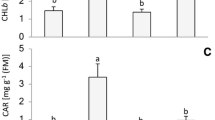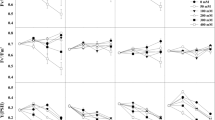Abstract
Investigations were carried out to study the high light stress effects on photosystem (PS) II efficiency in intact leaves of four rice (Oryza sativa L.) cultivars, viz., Jyothi, Aiswarya, Swarnaprabha and Kanchana. Rice seedlings were exposed to high light stress of 2000 µmol m−2 s−1, and the photochemistry of the four rice cultivars was studied by analyzing chlorophyll-a (Chla) fluorescence at 0 (control), 2 and 8 h. The results showed that Fv/Fo, performance index, area above the flourescence curve, Φo/(1 − Φo), ΦDo, ΦEo, Vj and DIo/CSo were found to be more reliable for exploring the effect of changes in PSII activity after high light stress application for short term (2 h), which can aid in distinguishing the tolerant and sensitive rice cultivars. Some Chla fluorescence parameters (Fm, SFI, Fv/Fm, Ψo/(1 − Ψo), ETo/CSo, ABS/CSo) were modified only after exposing the plants to high light stress for 8 h. The order of high light stress tolerance of these cultivars according to the analysis of Chla fluorescence parameters was Jyothi > Aiswarya > Swarnaprabha > Kanchana.
Similar content being viewed by others
Avoid common mistakes on your manuscript.
Light is an essential ingredient for plant’s survival, as it is the source of energy for photosynthesis, which has a strong impact on plant growth. However, when the absorbed light energy surpasses the rate of the photochemical reaction, photoinhibition occurs (Zhang et al. 2011). Photoinhibition results in membrane destruction, structural damage to chloroplasts and other organelles and reduction in photosynthetic activity (Roach and Krieger-Liszkay 2014). Plants reduce the harmful effects of this excess energy by dissipating as heat or fluorescence and not transferring the same to the reaction centers and thus protect the photosynthetic apparatus from photoinhibition (Jiao et al. 2004).
Chlorophyll (Chl) a fluorescence induction kinetics is highly sensitive and non-invasive useful parameter to study the electron transfer kinetics between the various components of PSII and it enables for the in vivo investigation of the behavior of PSII function during stress application (Strasser et al. 2004, 2010). Rice is one of the most important cereals and is grown mainly in tropical and subtropical regions and in this study, we investigated the effects of short and long term high intensity light stress on the photochemistry in four prominent rice cultivars, viz., Jyothi, Aiswarya, Swarnaprabha and Kanchana by assessing the Chl a fluorescence.
Seeds of rice cvs. Jyothi, Aiswarya, Swarnaprabha and Kanchana were obtained from Regional Agricultural Research Station, Pattambi. The seedlings were raised in half strength Hoagland medium and grown in a plant growth chamber set at 14/10 h light–dark cycles at 300 µmol m−2 s−1, 24 ± 2 °C temperature and 55 ± 5 % RH. After 9 days of growth, rice seedlings were exposed to high intensity light (2000 µmol m−2 s−1), provided by 1000 W PAR64 (Philips) metal halide lamps. Light intensity at the surface of the leaves was measured by a solar radiation monitor (EMCON, Cochin). The polyphasic Chla fluorescence was measured at different time intervals (0, 2 and 8 h) in the leaves of seedlings exposed to high intensity light.
Chla fluorescence transients were measured with the Plant Efficiency Analyzer (Handy PEA, Hansatech Ltd., Norfolk, UK). All measurements were performed on the upper surfaces of the youngest fully expanded leaves following a dark adaptation period of 20 min using the leaf clips. Maximal fluorescence was induced by a 1 s pulse of white light (3000 µmol m−2 s−1). Thereafter, Chla fluorescence signals were analyzed with the Biolyzer HP3 software (Strasser et al. 2004). Various fluorescence parameters like the maximal fluorescence (Fm), th ephotochemical efficiency of PSII (Fv/Fm), the activity of the water-splitting complex on the donor side of the PSII (Fv/Fo), the maximum quantum yield of non-photochemical de-excitation (ΦDo), the primary photochemistry [Φo/(1 − Φo)], the electron transport quantum yield (ΦEo), the thermal or non-light dependent reactions [Ψo/(1 − Ψo)], PSII structure–function-index (SFI), relative variable fluorescence at J step (Vj), performance index (PI) and area over the florescence curve were measured and the phenomenological energy fluxes per cross-section(ABS/CSo: absorption flux, ETo/CSo: electron transport flux and DIo/CSo: dissipated energy flux) were also calculated in response to high light stress in the four rice cultivars as reported by Kalaji et al. (2012). The data were analyzed by SPSS software version 16 using one-way analysis of variance (ANOVA) and the means were compared by Tukey’s studentized range (HSD) test.
Results showed that Fm, PI, Fv/Fo, area over the florescence curve and SFI decreased significantly with short and long term high light exposure in all rice cultivars (Fig. 1). On imparting high light stress, percentage decrease in Fm and PI in Kanchana and Swarnaprabha was higher with the increase in period of exposure (8 h); but it was comparatively less in Jyothi and Aiswarya (Fig. 1A–D). The decrease in area above the fluorescence curve suggests that high light stress inhibited the electron transfer from the reaction center to quinone pool in rice seedlings (Mathur et al. 2016). Structure–function-index (SFI) or vitality index refers to structural and functional PSII events leading to electron transport within photosynthesis and it was greatly decreased in all four rice cultivars when they were exposed to different duration of high light stress. By 2 h of stress application, Fv/Fo decreased more in Swarnaprabha and Kanchana (30 and 37 %, respectively) than for Jyothi and Aiswarya (14 and 8 %, respectively). But after 8 h of exposure to high light stress, all rice cultivars showed more or less similar percentage of reduction in Fv/Fo as compared to control plants (45–52 %). According to Pereira et al. (2000), the decrease in Fv/Fo when the lemon seedlings were treated with aluminium was the result of electron transport impairment during electron transport of photosynthesis.
Under high light treatment, the values of ΦEo and Ψo/(1 − Ψo) were significantly decreased (p ≤ 0.01) and it was predominant in Kanchana than in other three cultivars (Fig. 1). High light exposure caused a significant decrease in Φo/(1 − Φo) and the percentage of decrease was about 14, 17, 30 and 37 % in Jyothi, Aiswarya, Swarnaprabha and Kanchana, respectively, after short term exposure of high light stress (2 h). The results also showed that the rate of reduction was similar (41–50 %) in all cultivars with increase in duration of high light exposure to 8 h. Mmaximum quantum yield of non-photochemical de-excitation (ΦDo) and relative variable fluorescence at J step (Vj) increased significantly in Kanchana and Swarnaprabha than Jyothi and Aiswarya at 2 h, and it proved that high light stress negatively influenced the electron transport at the acceptor side of PSII and also short term high light exposure is adequate for studying the effect of photo-inhibition in rice cultivars. Similar observations have also been reported by Kalaji et al. (2012) in two barley cultivars, Arabi Aswad and Arabi Abiad, grown under different light intensities by analyzing the various parameters of Chla fluorescence, and it was found that the former was more tolerant while the latter was more sensitive to high light stress.
A decline in the photosynthetic efficiency is usually measured by a decline in the values of Fv/Fm, which represents the maximal photochemical yield of PSII (Ware et al. 2016). A significant reduction in Fv/Fm was observed in Kanchana (p ≤ 0.01) as compared to other cultivars (p ≤ 0.5) (Fig. 2). There are reports that even though it is an important parameter of the physiological state of the photosynthetic apparatus, in case of some abiotic stresses Fv/Fm ratio was not severely decreased in some plants (Amirjani 2010). The phenomenological energy fluxes per cross section such as, absorption flux (ABS/CSo), electron transport flux (ETo/CSo) and dissipated energy flux (DIo/CSo) decreased under high light stressed plants (Fig. 3A–C). These results were similar to earlier reports observed in Alhagispar sifolia when exposed to high light stress (Li et al. 2014).
According to Francies et al. (2013), Aiswarya is a moderately tolerant variety possessing resistance to moisture stress and blast at vegetative stage, Jyothi is known to be a high yielding rice variety, Swarnaprabha and Kanchana are susceptible to moisture stress and bacterial leaf blight. Our results confirmed that cultivars, Jyothi and Aiswarya, were highly tolerant, while cultivars Swarnaprabha and Kanchana were sensitive to high light stress. The above results conclusively proved that short term effect of high light is more effective for studying the effects of high light on rice cultivars and also some of the Chla fluorescence parameters, viz., (Fv/Fo, performance index, area above the flourescence curve, Φo/(1 − Φo), ΦEo, ΦDo, Vj and DIo/CSo) are important for assessing the high light tolerance potential in seedlings of different rice cultivars.
References
Amirjani, M. R. (2010). Effect of NaCl on some physiological parameters of rice. European Journal of Biological Sciences, 3, 6–16.
Francies, R. M., Joseph, J., Zachariah, G., Leenakumary, S., Raji, P., Karthikeyan, S., et al. (2013). PTB 59-‘Samyuktha’, a high yielding rice variety for kootumundakan system of cultivation in Kerala. Journal of Tropical Agriculture, 51, 66–73.
Jiao, S., Emmanuel, H., & Guikema, J. A. (2004). High light stress inducing photo-inhibition and protein degradation of photosystem I in Brassica rapa. Plant Science, 167, 733–741.
Kalaji, H. M., Carpentier, R., Allakhverdiev, S. I., & Bosa, K. (2012). Fluorescence parameters as early indicators of light stress in barley. The Journal of Photochemistry and Photobiology B: Biology, 112, 1–6.
Li, L., Li, X., Xu, X., Lin, L., Zeng, F., & Chen, F. (2014). Photosystem II activity of typical desert plant Alhagi sparsifolia Sharp: Response to exposure to natural light after being kept in shade. Trees, 28, 545–554.
Mathur, S., Kalaji, H. M., & Jajoo, A. (2016). Investigation of deleterious effect of chromium phytotoxicity and photosynthesis in wheat plants. Photosynthetica, 54, 1–8.
Pereira, W. E., de Siqueira, D. L., Martínez, C. A., & Puiatti, M. (2000). Gas exchange and chlorophyll fluorescence in four citrus rootstocks under aluminium stress. Journal of Plant Physiology, 157, 513–520.
Roach, T., & Krieger-Liszkay, A. (2014). Regulation of photosynthetic electron transport and photo-inhibition. Current Protein and Peptide Science, 15, 351–362.
Strasser, R. J., Tsimilli-Michael, M., Qiang, S., & Goltsev, V. (2010). Simultaneous in vivo recording of prompt and delayed fluorescence and 820-nm reflection changes during drying and after rehydration of the resurrection plant Haberlea rhodopensis. Biochimica et Biophysica Acta, 1797, 1313–1326.
Strasser, R. J., Tsimilli-Michael, M., & Srivastava, A. (2004). Analysis of the fluorescence transient. In G. C. Papageorgiou & Govindjee (Eds.), Chlorophyll-a fluorescence: A signature of photosynthesis advances in photosynthesis and respiration (pp. 321–362). Rotterdam: Kluwer Academic Publishers.
Ware, M. A., Dall’Osto, L., & Ruban, A. V. (2016). An in vivo quantitative comparison of photo-protection in Arabidopsis xanthophyll mutants. Frontiers in Plant Science, 7, 841. doi:10.3389/fpls.2016.00841.
Zhang, Y. J., Xie, Z. K., Wang, Y. J., Su, P. X., An, L. P., & Gao, H. (2011). Light intensity affects dry matter, photosynthesis and chlorophyll fluorescence of oriental lily. The Philippine Agricultural Scientist, 94, 232–238.
Acknowledgments
P. Faseela is indebted to Department of Science and Technology, New Delhi, India for the award of INSPIRE fellowship.
Author information
Authors and Affiliations
Corresponding author
Rights and permissions
About this article
Cite this article
Faseela, P., Puthur, J.T. Chlorophyll a fluorescence changes in response to short and long term high light stress in rice seedlings. Ind J Plant Physiol. 22, 30–33 (2017). https://doi.org/10.1007/s40502-016-0244-1
Received:
Accepted:
Published:
Issue Date:
DOI: https://doi.org/10.1007/s40502-016-0244-1







